Trochilinae
Trochilinae is a subfamily of the hummingbird family (Trochilidae). Members of the subfamily Trochilinae are sometimes called typical hummingbirds. They typically display iridescent plumage in metallic reds, oranges, greens and/or blues. Strong sexual dimorphism in plumage and size is evident in many species.[1]
| Trochilinae | |
|---|---|
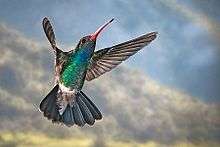 | |
| Broad-billed Hummingbird male Cynanthus latirostris, Madera Canyon, Arizona | |
| Scientific classification | |
| Kingdom: | Animalia |
| Phylum: | Chordata |
| Class: | Aves |
| Order: | Apodiformes |
| Family: | Trochilidae |
| Subfamily: | Trochilinae Jardine, 1833 |
| Genera | |
|
About 100, see text | |
Distribution
Hummingbirds in Trochilinae are found in America, from Alaska to the archipelago of Tierra del Fuego. There is great diversity in almost the entire Central American isthmus, Colombia, and Venezuela. The country with the greatest diversity of this species is Ecuador, which has 132 species equivalent to 40% of the world total, however the country with the highest number of these is Colombia with up to 165 species throughout its territory.[2]
Reproduction
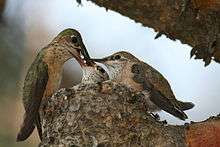
To court the interest of the female, the male performs a dance. After the females have been fertilized, they build a small nest lined internally with spider web, cotton, lichen or moss. The nest is often built in a low bush. The female lays two eggs in a period of two days and hatches within 14 to 19 days. Then, the hummingbirds feed their young for about three to four weeks at this time the female travels from the nest up to 140 times a day to feed her young.
Taxonomic list
| Image | Genus | Living species |
|---|---|---|
.jpg) | Topaza |
|
_male_Tr.jpg) | Florisuga |
|
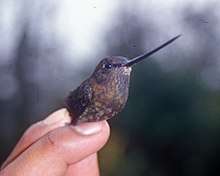 | Doryfera |
|
_(22653616465).jpg) | Schistes |
|
| Augastes |
| |
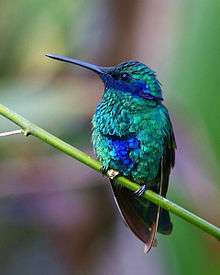 | Colibri |
|
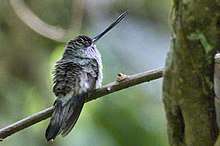 | Androdon |
|
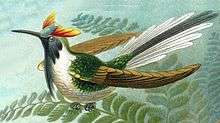 | Heliactin |
|
.jpg) | Heliothryx |
|
 | Polytmus |
|
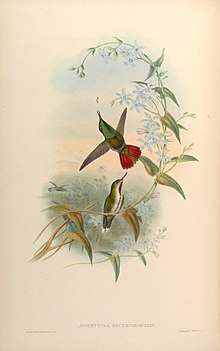 | Avocettula |
|
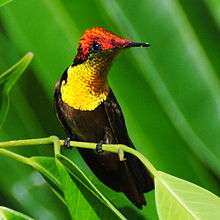 | Chrysolampis |
|
_-_Macho_(16247043591).jpg) | Anthracothorax |
|
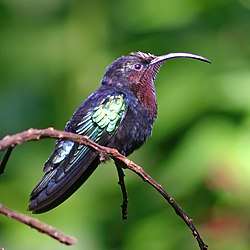 | Eulampis |
|
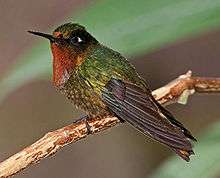 | Heliangelus |
|
 | Sephanoides |
|
 | Discosura |
|
.jpg) | Lophornis |
|
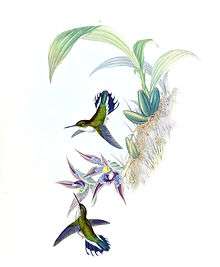 | Phlogophilus |
|
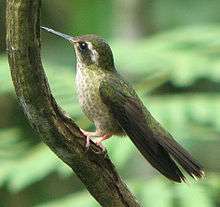 | Adelomyia |
|
_-_Juvenil_(17012254465).jpg) | Aglaiocercus |
|
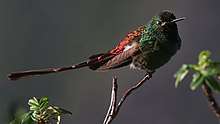 | Sappho |
|
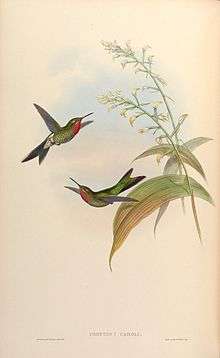 | Polyonymus |
|
 | Taphrolesbia |
|
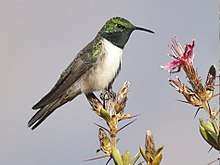 | Oreotrochilus |
|
 | Opisthoprora |
|
.jpg) | Lesbia |
|
_(8079763797).jpg) | Ramphomicron |
|
 | Chalcostigma |
|
.jpg) | Oxypogon |
|
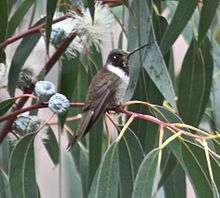 | Oreonympha |
|
.jpg) | Metallura |
|
 | Haplophaedia |
|
.jpg) | Eriocnemis |
|
 | Loddigesia |
|
_(15321782077).jpg) | Aglaeactis |
|
_4.jpg) | Coeligena |
|
.jpg) | Lafresnaya |
|
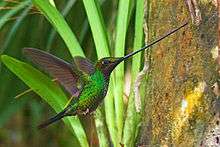 | Ensifera |
|
_JCB.jpg) | Pterophanes |
|
_(16804678517).jpg) | Boissonneaua |
|
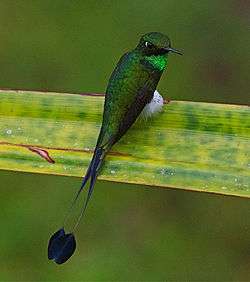 | Ocreatus |
|
_(14144500332).jpg) | Urochroa |
|
.jpg) | Urosticte |
|
_(19406173133).jpg) | Heliodoxa |
|
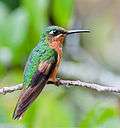 | Clytolaema |
|
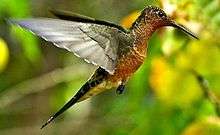 | Patagona |
|
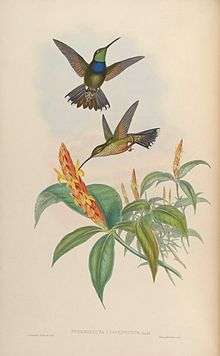 | Sternoclyta |
|
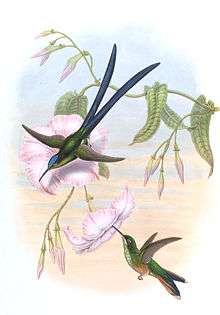 | Hylonympha |
|
 | Eugenes |
|
 | Panterpe |
|
_(16210613889).jpg) | Heliomaster |
|
.jpg) | Lampornis |
|
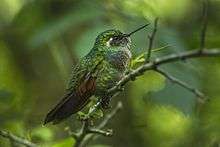 | Lamprolaima |
|
.jpg) | Calliphlox |
|
.jpg) | Myrtis |
|
 | Rhodopis |
|
 | Myrmia |
|
 | Thaumastura |
|
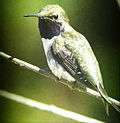 | Eulidia |
|
_(8077616362).jpg) | Microstilbon |
|
_2015-06-16_(3)_(26457944788).jpg) | Chaetocercus |
|
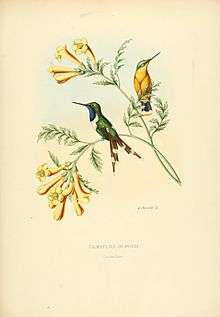 | Tilmatura |
|
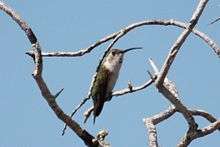 | Doricha |
|
.jpg) | Calothorax |
|
.jpg) | Archilochus |
|
_adult_male_non-breeding.jpg) | Mellisuga |
|
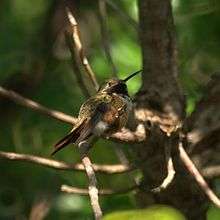 | Nesophlox |
|
%2C_male_(4205673916).jpg) | Calypte |
|
 | Selasphorus |
|
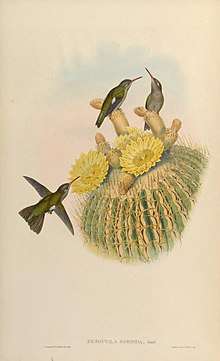 | Phaeoptila |
|
| Riccordia |
| |
 | Cynanthus |
|
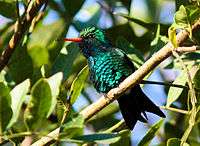 | Chlorostilbon |
|
.jpg) | Basilinna |
|
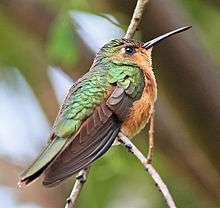 | Pampa |
|
 | Abeillia |
|
_JCB.jpg) | Klais |
|
 | Orthorhyncus |
|
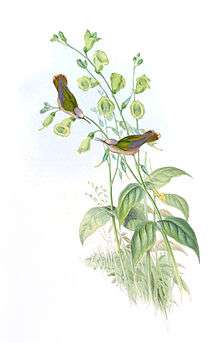 | Anthocephala |
|
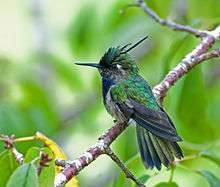 | Stephanoxis |
|
 | Campylopterus |
|
_crop.jpg) | Chalybura |
|
 | Thalurania |
|
.jpg) | Microchera |
|
.jpg) | Goldmania |
|
.jpg) | Eupherusa |
|
.jpg) | Phaeochroa |
|
 | Leucippus |
|
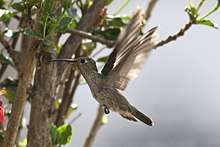 | Thaumasius |
|
 | Taphrospilus |
|
 | Eupetomena |
|
 | Talaphorus |
|
_adult_male_2.jpg) | Trochilus |
|
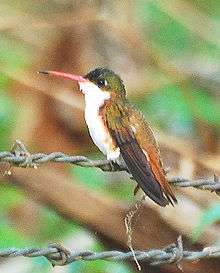 | Leucolia |
|
| Saucerottia |
| |
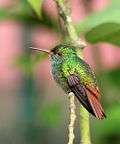 | Amazilia |
|
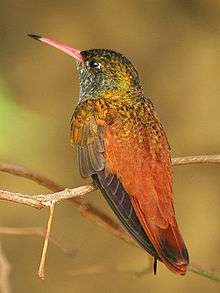 | Amazilis |
|
.jpg) | Uranomitra |
|
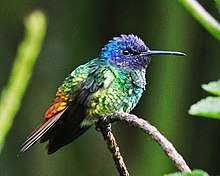 | Chrysuronia |
|
 | Leucochloris |
|
.jpg) | Chionomesa |
|
 | Hylocharis |
|
 | Elliotomyia |
|
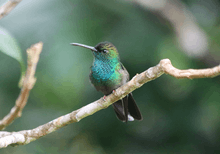 | Polyerata |
|
_male.jpg) | Chlorestes |
|
See also
- Phaethornithinae (the other subfamily of Trochilidae)
References
- "Our Beautiful World: Hummingbirds - Apodiformes, Trochilidae, Trochilinae, Phaethornithinae, Apodidae, swifts, Hemiprocnidae, treeswifts,". www.vulkaner.no. Retrieved 2020-07-27.
- "Change the generic classification of the Trochilinae (part 2)". www.museum.lsu.edu. Retrieved 2020-07-27.
External links

